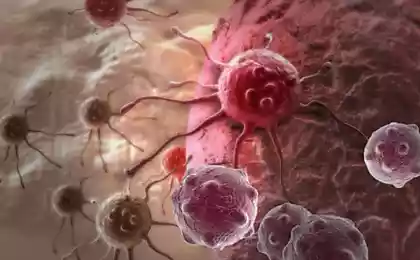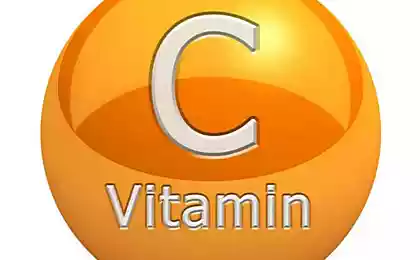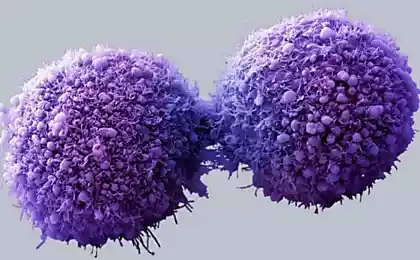438
Garlic against cancer, microbes and diabetes
Since time immemorial garlic has been used not only in cooking but also in medicine. It was used in the treatment of various ailments ancient Greek scientist Hippocrates. The roots of this plant form a scalloped head that contain numerous health enhancing phytonutrients in respect of which it is proved that they oppose coronary artery diseases, infections and cancer. Garlic belongs to the onion family (Alliaceae), a genus of Allium. Its scientific name is Allium sativum. It is believed that he comes from the mountainous region of Central Asia, whence it spread through all areas of the world with temperate and subtropical climates.

Resource Nutrition And You stand out healthy properties of garlic, as well as those cases in which people should abstain from eating. Mature plants reach 50-60 cm in height and have a root heads, each of which contains about 8-20 cloves-"Zubkov". Each of the slices covered with several layers of whitish husks, characterized by the thickness of the thin paper.
Cultivated several varieties of garlic, among which the giant elephant garlic (elephant garlic) and small monocots (solo garlic). Wild or field garlic is a common plant in the UK.
Unlike onions, garlic flowers are sterile and therefore do not produce seeds. New plants usually ripen from garlic cloves. Garlic is usually harvested when they are beginning to turn yellow lower leaves, a sign of dryness. Then it is dried outdoors in the shade. The dried garlic should be stored at room temperature in a cool dark place. In this case, he will remain for several weeks.
Contained in garlic sulfide (sulfur) compounds are metabolized by the body to allyl methyl sulfide and excreted in sweat and breath that leads to unpleasant taste and bad breath.
The benefits of garlic for health
Garlic has a strong odor. Its cloves contain many noteworthy phytonutrients, minerals, vitamins and antioxidants with proven abilities to improve their health. The total antioxidant rate of garlic (ORAC value) is 5346 µmol TE per 100 grams.
His head thiosulfinate contain organic (thio-sulfinite) compounds, including ingredients: diallyl-disulphide, ingredients: diallyl-trisulfide and allyl propyl disulfide. During grinding and cutting of garlic, these compounds convert to allicin in the process of enzymatic reactions (enzymatic reaction).
Laboratory studies have shown that allicin reduces the production of cholesterol by suppressing the enzyme 3-hydroxy-3-methylglutaryl-coenzyme a reductase (HMG-CoA reductase) in liver cells.
Allicin reduces the rigidity of blood cells by accelerating release of nitric oxide (NO). Nitric oxide relaxes blood cells and thus decrease the overall blood pressure. Moreover, it inhibits thrombus formation and has fibrinolytic action inside the blood cells. This property of allicin helps to lower the overall risk of coronary arterial disease, peripheral vascular disease and stroke.
Studies show that consumption of garlic may lead to lower likelihood of cancer of the stomach.
Allicin and other essential volatile compounds also possess antibacterial, antiviral and antifungal properties.
Garlic — excellent source of minerals and vitamins required for organism maintenance in a healthy condition. His head is one of the richest sources of potassium, iron, calcium, magnesium, manganese, zinc and selenium. Selenium is a heart-healthy mineral that is important factor related antioxidant enzymes in the body. Manganese is used by the body as a factor-associated antioxidant enzyme superoxiddismutase. Iron the body needs for the formation of red blood cells.
Garlic also contains many flavonoid antioxidants, including beta-carotene and zeaxanthin as well as vitamins, including vitamin C, contributing to the development of the body's resistance to infectious agents and cleansing from harmful free radicals that promote inflammatory processes.
The use of garlic in medicine
Green garlic has long been used in traditional Indian and Chinese medicine as a remedy for cold, cough, bronchitis and similar diseases.
Garlic oil applied to the skin at the point of defeat fungal dermatitis.
In modern medicine, this herbs is recommended as a healthy food thanks to its antimicrobial, anticancer, antidiabetic properties and ability to boost the immune system and lower cholesterol.
Caution
The cloves of garlic contains allicin that acts as "blood thinner" (anticoagulant). It should therefore be avoided in patients taking anticoagulants, as this combination may lead to increased bleeding.
Liquid spice garlic-based (including the marinade in vinegar) are favorable environment for the growth of Clostridium botulinum (botulin), causing a condition known as botulism (paralysis of nervous system). Therefore, compounds of garlic should be stored exclusively in the fridge and use as quickly as possible.
Nutritional value of garlic
In parentheses are the percentage of the daily allowance. Nutritional value is based on 100 grams of garlic (Allium sativum) according to information from the Ministry of agriculture of the USA, shown in the resource Nutrition And You.
General information:
P. S. And remember, only by changing their consumption — together we change the world! ©
Source: hi-news.ru

Resource Nutrition And You stand out healthy properties of garlic, as well as those cases in which people should abstain from eating. Mature plants reach 50-60 cm in height and have a root heads, each of which contains about 8-20 cloves-"Zubkov". Each of the slices covered with several layers of whitish husks, characterized by the thickness of the thin paper.
Cultivated several varieties of garlic, among which the giant elephant garlic (elephant garlic) and small monocots (solo garlic). Wild or field garlic is a common plant in the UK.
Unlike onions, garlic flowers are sterile and therefore do not produce seeds. New plants usually ripen from garlic cloves. Garlic is usually harvested when they are beginning to turn yellow lower leaves, a sign of dryness. Then it is dried outdoors in the shade. The dried garlic should be stored at room temperature in a cool dark place. In this case, he will remain for several weeks.
Contained in garlic sulfide (sulfur) compounds are metabolized by the body to allyl methyl sulfide and excreted in sweat and breath that leads to unpleasant taste and bad breath.
The benefits of garlic for health
Garlic has a strong odor. Its cloves contain many noteworthy phytonutrients, minerals, vitamins and antioxidants with proven abilities to improve their health. The total antioxidant rate of garlic (ORAC value) is 5346 µmol TE per 100 grams.
His head thiosulfinate contain organic (thio-sulfinite) compounds, including ingredients: diallyl-disulphide, ingredients: diallyl-trisulfide and allyl propyl disulfide. During grinding and cutting of garlic, these compounds convert to allicin in the process of enzymatic reactions (enzymatic reaction).
Laboratory studies have shown that allicin reduces the production of cholesterol by suppressing the enzyme 3-hydroxy-3-methylglutaryl-coenzyme a reductase (HMG-CoA reductase) in liver cells.
Allicin reduces the rigidity of blood cells by accelerating release of nitric oxide (NO). Nitric oxide relaxes blood cells and thus decrease the overall blood pressure. Moreover, it inhibits thrombus formation and has fibrinolytic action inside the blood cells. This property of allicin helps to lower the overall risk of coronary arterial disease, peripheral vascular disease and stroke.
Studies show that consumption of garlic may lead to lower likelihood of cancer of the stomach.
Allicin and other essential volatile compounds also possess antibacterial, antiviral and antifungal properties.
Garlic — excellent source of minerals and vitamins required for organism maintenance in a healthy condition. His head is one of the richest sources of potassium, iron, calcium, magnesium, manganese, zinc and selenium. Selenium is a heart-healthy mineral that is important factor related antioxidant enzymes in the body. Manganese is used by the body as a factor-associated antioxidant enzyme superoxiddismutase. Iron the body needs for the formation of red blood cells.
Garlic also contains many flavonoid antioxidants, including beta-carotene and zeaxanthin as well as vitamins, including vitamin C, contributing to the development of the body's resistance to infectious agents and cleansing from harmful free radicals that promote inflammatory processes.
The use of garlic in medicine
Green garlic has long been used in traditional Indian and Chinese medicine as a remedy for cold, cough, bronchitis and similar diseases.
Garlic oil applied to the skin at the point of defeat fungal dermatitis.
In modern medicine, this herbs is recommended as a healthy food thanks to its antimicrobial, anticancer, antidiabetic properties and ability to boost the immune system and lower cholesterol.
Caution
The cloves of garlic contains allicin that acts as "blood thinner" (anticoagulant). It should therefore be avoided in patients taking anticoagulants, as this combination may lead to increased bleeding.
Liquid spice garlic-based (including the marinade in vinegar) are favorable environment for the growth of Clostridium botulinum (botulin), causing a condition known as botulism (paralysis of nervous system). Therefore, compounds of garlic should be stored exclusively in the fridge and use as quickly as possible.
Nutritional value of garlic
In parentheses are the percentage of the daily allowance. Nutritional value is based on 100 grams of garlic (Allium sativum) according to information from the Ministry of agriculture of the USA, shown in the resource Nutrition And You.
General information:
- the energy value is 149 calories (7.5 per cent);
- carbohydrates 33.06 grams (25%);
- protein of 6.36 grams (11%);
- fat — 0.5 grams (2%);
- fiber, part of the food — 2.1 grams (5.5 per cent).
- folic acid (vitamin B9) is 3 micrograms (1%);
- nicotinic acid (vitamin B3) — 0,700 mg (4%);
- Pantothenic acid — 0,596 milligrams (12%);
- pyridoxine (vitamin B6) — 1,235 milligrams (95%);
- Riboflavin (vitamin B2) — 0,110 mg (8%);
- thiamine (vitamin B1) 0,200 milligrams (17%);
- vitamin C 31.2 mg (52%);
- vitamin E — 0.08 milligram (0,5%);
- vitamin K is 1.7 micrograms (1.5 percent).
- sodium, 153 milligrams (10%);
- potassium 401 mg (8.5 per cent).
- calcium 181 mg (18%);
- copper — 0,299 milligrams (33%);
- iron — 1.70 milligrams (21%);
- magnesium is 25 milligrams (6%);
- manganese — 1,672 milligrams (73%);
- phosphorus 153 mg (22%);
- selenium — 14.2 micrograms (26%);
- zinc — 1,160 milligrams (10,5%).
- beta-carotene (ß-carotene) is 5 micrograms;
- beta-cryptoxanthin (ß-cryptoxanthin) — 0 micrograms;
- lutein-zeaxanthin — 16 micrograms.published
P. S. And remember, only by changing their consumption — together we change the world! ©
Source: hi-news.ru
Jaguar will teach cars to read the driver's mind and to follow health
They have to write on the label?
























